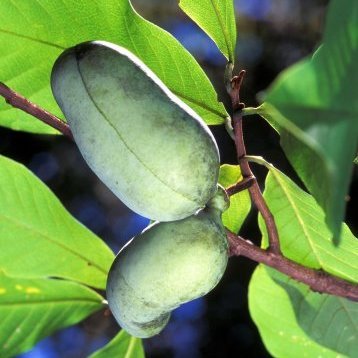Pawpaw - Potted
Pawpaw - Potted
964 in stock
Couldn't load pickup availability
WE DO NOT SHIP POTTED PLANTS.
Potted pawpaws are available for **PICKUP ONLY** in September in Champaign, IL, or Prairie du Chien, WI, for fall planting (select location at check out). We will contact you once your trees are ready to schedule a pickup time. Pawpaw will not be available for pickup in Columbus Junction IA.
Pawpaw (Asimina triloba) has a 4 – 6 inch long tropical-looking fruit with a rich banana/mango flavor. Indeed, the pawpaw is the only temperate species in the Annonaceae family.
![]() Seed Source
Seed Source
We source our seed each fall from a range of the best pawpaw trees at Red Fern Farm. This ensures that the seedling trees you buy have the highest chance of producing high yields of top-notch fruit. These seedlings are open pollinated with grafted varieties such as ‘NC1’, ‘Pennsylvania Golden’, ‘Taytwo’, ‘Prolific’, ‘Shenandoah’, ‘Susquehanna’ and ‘Overlease’ as their mother tree. Please note, that the trees we sell are seedlings from known mothers, not specific cultivars.
When small, these trees are fragile and require a 2′ tree tube to establish. Two trees are needed for cross-pollination.
Potted plants must be ordered in multiples of 12. Potted plants are grown in 4″x4″ square pots that are 9.5″ tall, specifically selected to develop a strong root system on the plants.
Will it thrive?
Suited for USDA Plant Hardiness Zones: 5b-8b (experimental up to 5a)
Stop! Before you buy these pawpaw....are you sure they will thrive in your soil and climate? To be sure, you should prepare a Compass Report for your farm at CanopyCompass.com.
Growing Information
A basic guide to planting potted trees:
-
Potted trees can be planted anytime the ground is thawed. Potted trees must be planted early enough so roots can grow into the surrounding, undisturbed soil and become anchored before the ground freezes. If planted too late, frost action may heave the tree from the ground.
-
To avoid this, plant by early October.
Site Selection
-
Most fruit and nut trees require moist, well-drained soil.
-
Chestnuts require slightly acidic soil but will tolerate dryer, sandier soil than many other trees.
-
Persimmons, pawpaws, and pecans will tolerate much wider soil conditions (including periodic flooding) than most trees.
Spacing
-
Most of these trees will do well with a 20 x 20-foot spacing initially but may need to be thinned to 20 x 40 feet or 40 x 40 feet after 20 years.
-
Papaws are small trees, and a 10 x 10 foot or even 10x 20 foot spacing may be better for them.
To Plant
-
Water the tree pots thoroughly. If the soil in the pot is very dry (the tree and pot feel light), soak them in 2 - 6 inches of water until the soil at the top of the pot is moist. Remove them from the water and allow them to drain one hour before planting.
-
Dig a hole the same depth as the depth of the soil in the pot, no deeper.
-
Turn the pot upside down and shake the pot (don’t squeeze). The goal is for the tree, roots, and dirt to slide out of the pot as one mass. Catch it in your hand as it comes out. Be careful not to let the soil fall away from the roots (pre-watering will help).
-
Place the root mass in the hole and hold it upright with one hand while you backfill around it with the other. Use only the native soil at the planting site. Avoid mixing in fertilizer, compost, or other additives.
-
Firm the soil around the tree roots to exclude air pockets.
WATER!
Water right after planting and when the soil feels dry 3 - 4 inches below the surface.
Maintenance
-
Improper or inadequate maintenance is the #1 reason for tree planting failure. Trees must be protected from clumsy feet, mowers, deer, rabbits, and weed competition, especially grasses.
-
The best combination is a tree shelter with a weed mat, such as landscape cloth around the tree.
-
A layer of wood chips or mulch over the weed mat may also be beneficial.
-
Competent pesticide applications can substitute herbicides for mulch. If using herbicide, consulting a licensed professional is recommended.
-
Mowing by itself is not enough for weed control.
-
Do not use solid/unvented tree shelters. Appropriate tree shelters can be purchased from Canopy Nursery
Warning! Sun Scald
-
Our potted trees are grown under shade cloth.
-
As a result, they can get sun scald (sunburn) very quickly.
-
Tree shelters/ tubes/protectors provide them with the perfect amount of filtered light.
-
Do not leave your tree in direct sun for more than 30 minutes between 10:00 am and 2:00 pm during bright summer days.
-
They can be acclimated to direct sun by exposure to morning and /or afternoon sunlight
We recognize these factors may be overwhelming, but we are here to offer support and assistance on your tree-planting journey! Please schedule a call if any of these instructions need clarification or if you have any questions or concerns.



